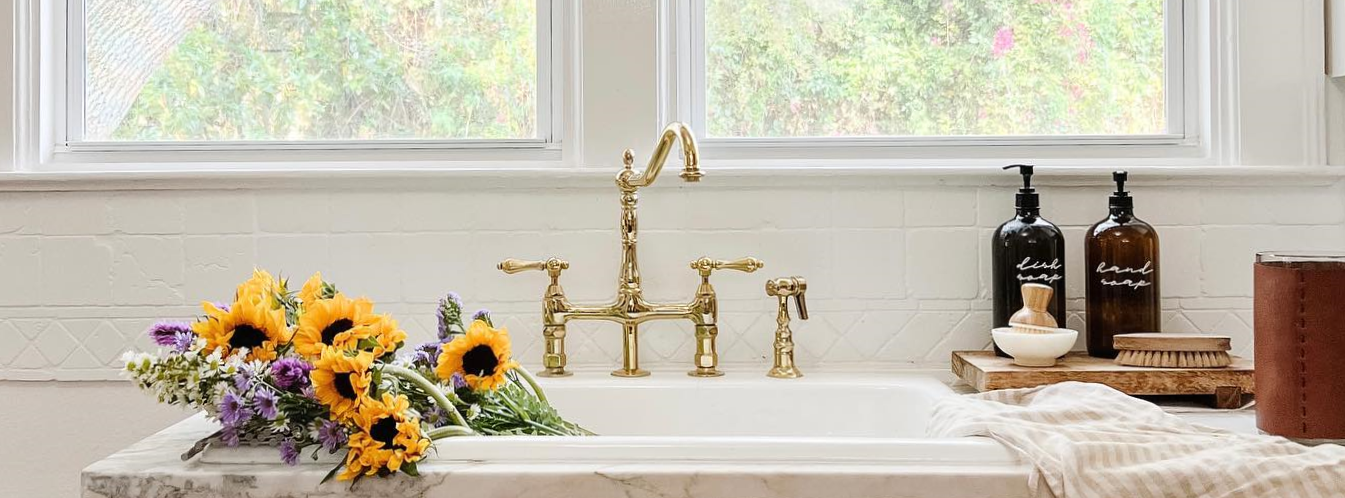Get [PRO] Pricing
Get [PRO] Pricing

Brass faucets have earned a well-deserved reputation for their durability and longevity. In this guide, we thoroughly explore the intricacies of brass faucets, including their construction, composition, and durability. Whether you're a homeowner embarking on a renovation project or a contractor sourcing fixtures for an installation project, this detailed breakdown of brass faucets will provide you with the knowledge needed to make confident decisions on the best brass faucet to try out.

Brass, an alloy primarily composed of copper and zinc, holds a significant place in the realm of metalworking and manufacturing. Brass is also one of the best materials for a bathroom or kitchen faucet. Its historical significance spans centuries, with its versatility and durability making it a favored material across various applications, including the crafting of plumbing fixtures like faucets. You can typically find items such as musical instruments, plumbing fixtures, electrical components, and jewelry to be made out of brass.
Copper serves as the primary component in brass, imposing its strength, malleability, and corrosion resistance to the alloy. Meanwhile, the addition of zinc enhances brass's hardness and durability. This intricate balance of elements underscores the complexity of brass alloys and underscores the importance of precision in their formulation for faucet manufacturing. Brass also has natural antimicrobial properties that contribute to maintaining hygiene standards in plumbing fixtures.

Some faucets that claim to be brass, are sometimes plastic faucet bodies coated with brass. These types of faucets tarnish and age much quicker than real solid brass faucets. Consumers may encounter issues such as chipping, peeling, and degradation with brass-coated plastic fixtures, leading to premature replacement and added costs in the long run. Brass faucets are built to withstand the rigors of daily use, making them particularly suited for high-traffic areas where durability is necessary.
Solid brass faucets are much heavier in weight, and are more durable than plastic faucet bodies. Over time, they are much better at enduring hard water, high frequency use, and minor dings. Therefore, investing in solid brass faucets proves to be more cost-effective over time, offering superior durability and performance that outlasts cheaper alternatives.

Examining the weight of real brass faucets reveals important insights into their quality and durability. Solid brass faucets exhibit a substantially heftier weight compared to other materials, a characteristic that stems from the density of brass itself. This weightiness signifies a higher level of quality and durability, instilling confidence in the longevity and reliability of these fixtures.
In contrast, brass-coated plastic faucets are notably lighter in weight when compared to their solid brass counterparts. This significant difference in weight raises questions about quality and durability. While lighter weight may initially suggest convenience, it can also indicate a compromise in material strength and resilience.

The alloy of copper and zinc in brass provides it with remarkable strength and resilience, making it resistant to various forms of degradation. This helps brass to withstand exposure to water, chemicals, and fluctuating temperatures without compromising its structural integrity.
Environmental factors such as moisture and air quality influence the rate at which tarnishing occurs on brass fixtures, particularly unlacquered brass, highlighting the importance of proper maintenance.

Regular cleaning and polishing are recommended to preserve the look of brass, removing tarnish and restoring their shine.
Another aspect that adds to brass’ longevity is the use of PVD technology. PVD is a vaporized version of a chosen material, such as titanium, aluminum, and zirconium. In a vacuum chamber, the vapor condenses and adheres to the surface of whatever item is placed in the chamber, in this case it is a faucet. PVD-coated finishes are resistant to scratches, chips and fading. There are other factors that contribute to a faucet’s durability, so it’s important to fully understand the colors and finishes available.

Brass faucets are renowned for their exceptional lifespan, owing to their robust construction and corrosion-resistant properties. With solid brass as the primary material, these fixtures withstand the test of time with remarkable longevity.
When comparing the longevity of brass faucets to other materials, notable differences become apparent. Stainless steel, chrome-plated brass, and plastic faucets may have shorter lifespans due to factors such as material degradation and corrosion susceptibility. These materials often require more frequent maintenance and replacement, resulting in higher long-term costs. In contrast, brass faucets offer extended lifespan and minimal maintenance needs, making them a cost-effective investment over time. Their durability and reliability ensure lasting performance, providing homeowners and businesses with peace of mind.
